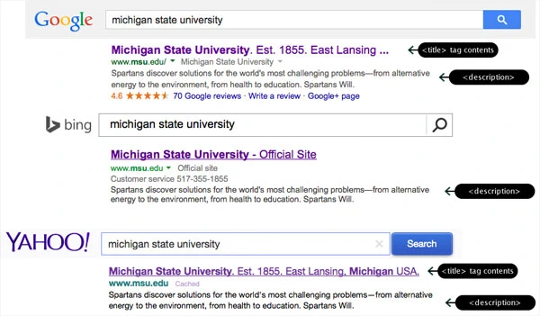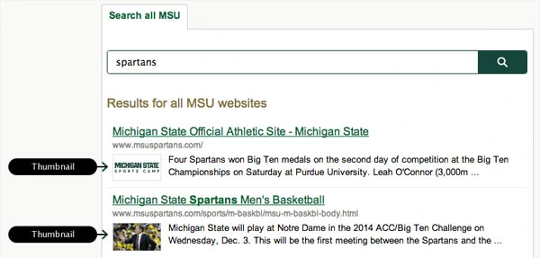Optimize for Search
- Build the website to be responsive so that it looks nice on any sized device.
- Generate a Google site map so search engines can understand the website structure.
- Use Google PageSpeed Insights to ensure the website loads quickly.
Social Media Icons
Follow social media network guidelines for displaying icons and buttons. See “Integrating Social and Websites” for more information.
Meta Tags, Open Graph and X Cards
Social media networks and search engines use a webpage’s open graph, X card, and meta tags when displaying summaries of and links to individual webpages. This helps content stand out when it is viewed in search results or shared to a social media feed.
Links to institutional webpages available via social media and search are easier for potential visitors to understand and evaluate when well-written open graph, X card and meta tags have been included. Social media managers, website managers and website content creators should work together to ensure open graph tags and X cards are available and are properly used.
Open Graph and Meta Tag Use and Placement
- Include open graph and meta tags on every institutional webpage.
- Include X card meta tags on featured/important MSU articles, media releases, multimedia elements and information pages.
- Place open graph and meta tags between HTML <head></head> tags.
Descriptive Page Headings
- Include at least one <h1> HTML tag that describes the main subject of the webpage.
- Include <h2> through <h6> HTML tags for longer, complex documents.
- Avoid gaps in the heading hierarchy (e.g., skipping from <h1> to <h3>).
- Include key words and phrases in headings to describe content.
- Use clear language that is easy to comprehend.
- Use the fewest words possible.
Meta Tags
Meta tags are standard tags used on search engines to determine what a website is about and how the content on the website is structured. Search engines “crawl” a site, including the meta data, and use this information when providing search results to internet users.
Expand the tabs below to review some tips and best practices related to adding meta tags on the website.

Well-written titles can generate more visits to a webpage and improve search engine visibility.
- Clearly summarize the content or benefit of the webpage.
- Include key words and phrases that visitors would use when searching for information contained within the webpage.
- Use 70 characters or less.
The content of the description tag should contain an abstract of what information is contained on an individual webpage.
- Use text that is easy to read.
- Include important keywords related to the content on the page.
- Provide context for the information the visitor will find by following the link to the page.
- Use 155 characters or less.

A thumbnail image for a page can be manually specified. This small image will appear next to the search result.
Add a thumbnail meta tag to the <head> section of the webpage (replace the URL with the path to the thumbnail image):
<meta name=“thumbnail content=“http://url.msu.edu/thumbnail.jpg” />Open Graph Tags
Open graph tags are standard tags used by many social media channels, including Facebook, to display summaries and media when a link to an individual webpage is shared on the channel.
Open graph tags should be used on every institutional webpage. Tags are placed between the HTML <head></head> tags.
Expand the tabs below to review some tips and best practices related to adding open graph tags on the website.
Include the text that should appear by default when a link to a webpage is shared via social media.
Include a one-to-two sentence summary describing the contents of the specific webpage.
Do not reuse the title or use this field to describe the general services provided by the unit or website.
Specify the kind of object/content being linked.
For example, <meta property=“og:type” content=“website”/> is used when linking to a website.
Include a URL for the graphic to be used when displaying a thumbnail preview along with a link to the webpage via social media.
Include the URL of the webpage being linked. The URL serves as the permanent link to the content. As such, content authors should link directly to the story/page, not a homepage featuring a link to the story/page.
Validate open graph to use.
To test, visit Meta’s Test Your Markup webpage.
For complete details on open graph tags, see the Open Graph Protocol website.
Visit the Meta for Developers website for Facebook-specific assistance.
X Cards
X cards, also known as Twitter cards, make it possible to attach media experiences to X (formerly Twitter) posts linking to web content from a website. Adding a few lines of HTML to webpages power these cards for X users that link to that page in one of their posts. Cards help provide additional context for the link, such as a thumbnail image and headline.
X card meta tags should be included on featured or important MSU articles, media releases, multimedia elements and information pages. Tags are placed between the HTML <head></head> tags.
The most commonly used cards for MSU websites are Summary Card and Summary Card with Large Image.
Expand the tabs below to review some tips and best practices related to creating X cards on the website.
For a Basic Summary Card, set the value to “Summary.”
Be concise. Use 70 or fewer characters for best appearance on X.
Include the @username used by the website (e.g., @MichiganStateU).
Include the @username of the content creator.
Summarize the content of the specific page. Use 200 or fewer characters. Keep search engine optimization in mind.
Do not reuse the title or use this field to describe the general services provided by the unit or website.
Include a URL for a unique image representing the content of the specific page. The image should use a minimum square aspect ratio of 120 pixels x 120 pixels and be less than 1MB in size.
Do not use a generic graphic or image used as the card image for other pages on the website.
Validate a card prior to use.
For information on testing a card, visit the X card validation tool. Click the Validator Tool link and log in to an account.
For complete details on X cards, see the developer user guide.